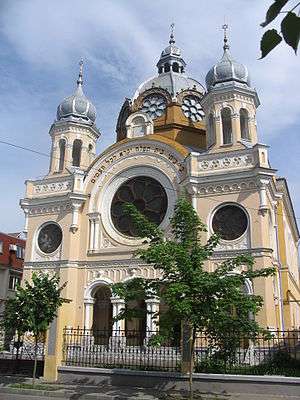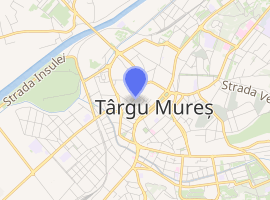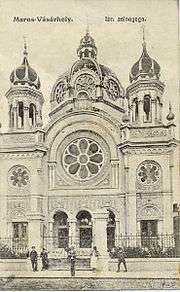Status Quo Synagogue
The Synagogue Status Quo Ante from Târgu Mureș (also known as the Great temple or the Great synagogue), located at No. 24, Aurel Filimon street (previously known as No. 21 Școlii street, entrance at #23), is the cultural centre for the small Jewish community in the city of Târgu Mureș proper, as well as the larger Transilvanian region. It was originally constructed during the Austro-Hungarian period, in 1899–1900, in an eclectic architectural style.
| Synagogue Status Quo Ante | |
|---|---|
 | |

| |
| General information | |
| Architectural style | Eclecticism |
| Town or city | Târgu Mures |
| Country | Romania |
| Completed | 1900 |
| Design and construction | |
| Architect | Jakob Gartner |
In 2004, the synagogue Status Quo Ante from Târgu Mureș was added to the list of historic monuments for Mureș County, under registration code MS-II-mB-15544[1]
Jewish community in Târgu Mureș
The presence of Jews in Târgu Mureș is recorded as far back as 1682. Over the next few decades, the Jewish community in the city grew very quickly, such that by the time Transilvania, under Austro-Hungarian control, was known as Grand Principality of Transylvania, it was second in size only to the one in Alba Iulia.
By around 1785 or so, the Jewish community in Târgu Mureș had just one wooden synagogue to congregate in, which could fit between 150–200 people. By 1870, the community grew to around 1,511[2] people.
The Jewish population played an important role in the development of the city. Jews would be found amongst a wide range of professions – editors, merchants, industrialists, bankers, doctors and small scale artisans. A youth school was founded in 1880, which moved in 1890 into a house on Horia street. During the 19th century, and as part of the Schism in Hungarian Jewry, a majority of the community moved away from orthodox judaism, and adopted the Status Quo Ante monicker – a monicker specifically used by some Jewish communities in Transilvania (traces of which can still be found in parts of Romania, Hungary, Slovakia and the Ukraine).
The size of the Jewish population continued to grow through the first part of the 20th century, up until the start of World War 2, passing 2755 in 1910 and 3246 in 1920 respectively, to a peak of 5693 in 1941. By the time of the Interwar period, the community was operating two synagogues – the Great Synagogue on Școlii street, and another one on Brăilei street, for a total seating capacity of 1200.
The Second Vienna Award and the annexation of northern Transylvania into Hungary in September 1940 was catastrophic for the Jewish community in the city. By 1944, the city had attracted many refugees from the smaller cities and villages in the area, and the population was estimated to be around 8000, representing approximately 16% of the population of Târgu Mureș.[3] The Hungarian authorities, under instructions from admiral Miklós Horthy – who was at the time regent of the Kingdom of Hungary and an ally to the Third Reich – moved the Jewish population into a ghetto installed in an ancient brick factory.
Between 27 May and 8 June 1944, under orders received from Adolf Eichmann, the Jewish population from Târgu Mureș and the surrounding region was deported to Auschwitz. Almost none of the 7550 deported Jews survived.[4]
After the end of World War 2, most of the survivors of the Shoah moved to Israel. The remaining Jewish community in Târgu Mureș was greatly reduced – in a 1977 census, only 646 Jewish citizens were counted in the entire Mureș County. By the start of the 21st century, the population was further reduced, and was no bigger than 200 in Târgu Mureș.[5]
History of the Great Synagogue

The grand synagogue in Târgu Mureș was built in 1899–1900 -during the austro-Hungarian period, in an eclectic architectural style, following plans provided by the vienese architect Jakob Gartner, of moravian descent. The start of construction of the synagogue at the end of the 19th century signaled, for the "Status Quo" Jewish community of Târgu Mureș, a definitive detachment from the orthodox Jewish community in the rest of Transylvania.
The synagogue was inaugurated in 1900 by rabbi Dr. Joachim Wilhelm, in the presence of leaders of the local Jewish community: Adalbert Burger (president for the community) and Mendel Farcas (vice-president). The inauguration celebrations took 3 days and 3 nights.[6] A marble plaque, placed in the entrance hall, is marked with the names of principal donors to the construction.[7] The synagogue continues to be known to this day under the familiar name Sinagoga de pe ulița Școlii (the synagogue on School Lane) also in Hungarian Iskola utcai Zsinagóga, despite the eventual change of name for the street, and change of address for the synagogue.
In 1998, with funding provided by the Federation of the Jewish Communities in Romania and by various private donors, a renovation was started, reaching eventual completion in 2000. Significant work was performed, including reinforcing the walls and foundations, interior and exterior restoration, closely matching and following the original architectural designs and paint. Most of the efforts to raise funds, oversee and complete the restoration, and rehabilitate the synagogue, were performed by the president of the community, Bernath Sauber, and by his secretary, Alexandru Ausch. The building was re-inaugurated in 2000.
According to the publication Seventy years of existence. Six hundred years of Jewish life in Romania. Forty years of partnership FEDROM – JOINT (Sixty-six years of existence. Six centuries of Jewish life in Romania. Forty years of partnership FEDROM – JOINT) edited in 2008, by the Federation of the Jewish Communities in Romania, which contains a list of all of the synagogues in Romania, the synagogue Status Quo Ante from Târgu Mureș is marked as being in service.[8]
The current synagogue sports 552 seats, 314 on the lower level and reserved for men, and 238 on the upper level, reserved for women.
The Synagogue's Architecture
The eclectic architecture presents itself as a mix of styles. The exterior contains typically roman architectural elements, mixed with some elements showing gothic inspiration – for example the rose windows – as well as some showing moorish inspiration, such as scalloped profiles or domes which borrow from Islamic architecture. As part of the last restoration, the building was repainted in an apricot color, with all of its ornaments and window frames painted in white.
The synagogue is possessed of a large, octagonal, central tower, with small rose windows on each of its sides, and topped by a roof lantern, as well as two smaller, octagonal, towers, topped by onion domes at each of the two corners of the facade. Each tower is topped with a Star of David.
The entrance to the synagogue is a gate with three arcades, separated by twin columns and backed by pillars. Underneath the entrance, sits a gothic central rosette with an inscription, quoting the Tanach in Hebrew: "My house is a house of prayer, for all the people[9]" (Book of Isaiah 56-7).
Roses decorate the two towers, at the facade's corners, on the first floor. The doorways on the ground floor for the two towers open to stairs, allowing women exclusive access to the second floor's seats.
The interior of the synagogue continues in the eclectic style, remaining "luxurious, but in good taste[7]". The architectural forms are brought into relief in the profile fo the various arches, the consoles, the various tracery and carved, coloured, elements. The style shows inspiration from roman, gothic and baroque architectural styles and elements, and follows patterns found in Catholic churches built during the same period. The interior is richly decorated, both in shape and in an abundance of colors: the railing for the women's gallery, built out of cylinders separated by geometric motifs, whites inside colored circles on a green background, four rose marble columns, cylindrical on an octagonal base, supporting the cupola from its sides, painted in green, yellow and orange parts on a blue and red background, the central Bimah surrounded by a railing in two shades of green.
The rustic wooden benches for the faithful are located opposite the Torah ark in four rows, at the rear of the synagogue, one row on each side of the Bimah and in front of it.
Opposite the entrance is a square apse – the Torah Ark – where the precious Torah scrolls are enclosed, in a semi-circular region supported by two columns, and topped by a bulb dome. Attached to the gate of the Ark, a plaque recalls the memory of the victims of the shoah. The inscription (in Hebrew) reads:
"Our city counts 5943 martyrs. The stones of the walls themselves, and the whole of the Jewish people mourn the extermination of our parents and our dear loved ones who were asphyxiated and burned at Auschwitz in the year 5704 (1944).[10]"
Photos of the interior of the synagogue
Notes
- (in Romanian): Lista monumentelor istorice din județul Mureș din anul 2004
- (in Romanian): Cuvântul Liber: Statistica evreilor din județul Mureș; 20 avril 2007–
- (in Romanian): Sinagoga Tirgu-Mures; website for the synagogue
- Randolph L. Braham and Attila Pok: The Holocaust in Hungary I-II; Editor: East European Monographs; 15 April 1997; ISBN 088033374X, 978-0880333740
- (in Romanian):
- (in Romanian):
- (in Romanian): Situl Sinagogii din Tg. Mureș
- The Federation of Jewish Communities of Romania (FEDROM): Seventy years of existence. Six hundred years of Jewish life in Romania. Forty years of partnership FEDROM – JOINT; 2008; page: 72
- (in French):Livre d'Isaïe; Version Chanoine Crampon; 1923
- (in Romanian): Arhitectura sinagogii
External links
- (in Romanian): Website for the Targu Mureș synagogue
- (in Romanian): Cuvântul Liber: Statistica evreilor din județul Mureș (Statistics related to Jews in Mureș County); 20 avril 2007




